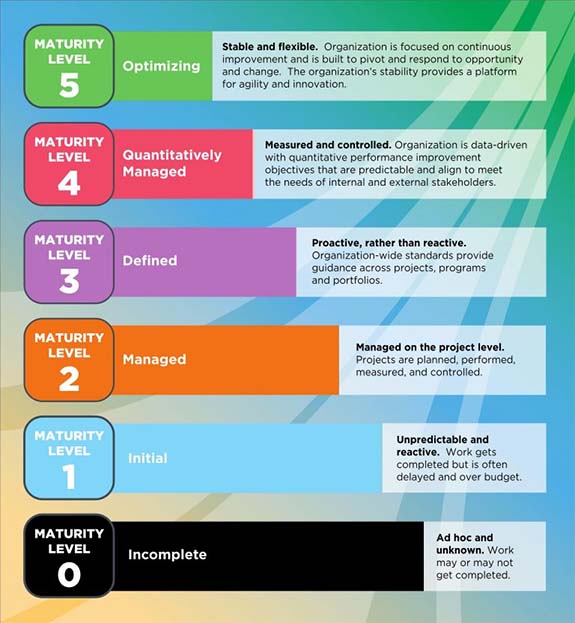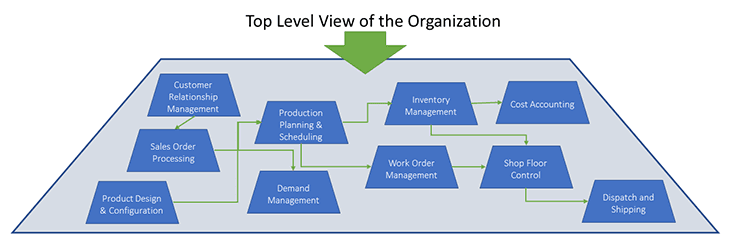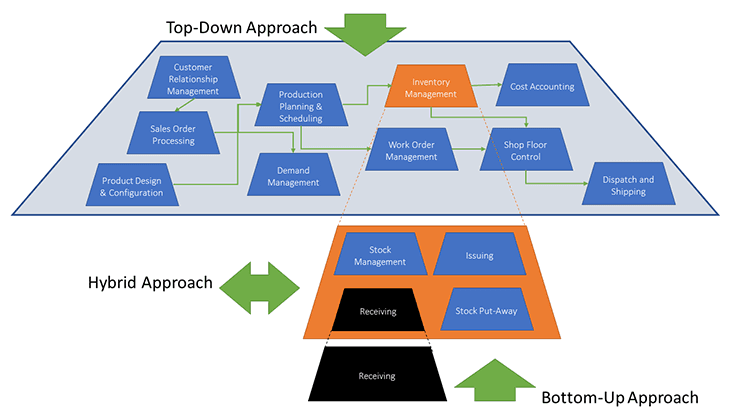BPM Implementation: Top-Down or Bottom Up Change?
By Mike Raia ![]() | Published September 8, 2021
| Published September 8, 2021
What Kind of Organization Are You?
Before we can select an approach to Business Process Management (BPM) implementation, we need to understand the organization's culture and the objectives of the organization’s BPM implementation. In addressing these areas, the organization needs to consider a few factors.
Does the culture of the organization encourage and embrace change?
Making any change in an organization is difficult, but it is more so when the changing area affects people’s daily work routines (i.e., the business processes). BPM requires communication and understanding. Fear creeps in immediately as people feel threatened by the change, and they will resist. Thus, it is important to assure the employees that this change will not result in job losses and that the change will benefit both the employees and the organization with better efficiency and effectiveness.
Are the objectives clear and realistically achievable, given the resources and timescales allocated to the project?
Many implementation projects aim for the moon but are given limited resources, the wrong skill sets, and totally unrealistic completion timelines. You would never consider using a Ford Pickup with a new driver for a World Rally championship. Yet, that is exactly what happens in some software implementation projects. It’s no wonder then to find failed projects littering the road to success so frequently. Ensuring that adequate and suitable resources are enlisted for the project, and the team is given realistic implementation timescales will considerably improve the project's success.
Evaluating Your Organization’s Maturity Level
Having addressed these management-level strategic issues, the next stage is to consider the current maturity level of the organization’s business processes. This will provide a systematic approach to what is the most appropriate way forward for implementation.
Process maturity assessment has been around for many years. Still, it has become popular in the last few years, as companies want to understand their current level of maturity and what it entails to get to the next level. Once you have assessed where you are on a process maturity scale, it allows you to identify what approach is best for your organization – top-down, bottoms-up, or other hybrids of these approaches.
There are several Process Maturity models available. They all have a common goal of assessing where your organization is on the scale. This then provides the platform for improvement. An example of a maturity model is the Capability Maturity Model Integration (CMMI) Process model shown below:

Whatever model you choose, a process maturity model is used to:
- Identify your current position on the maturity model in terms of a level
- Provide a path to evolve from less mature levels to well-organized and disciplined business processes - a higher level on the model. This is not necessarily the top maturity (5) level. If you are at level 1, it may take several iterative processes to move up the levels. For some organizations, the payback for the investment may not justify all the way to the top level.
All process maturity models have their own assessment methods. The organization can use these for self-assessment or employ external specialists to make this assessment.
So, after having made an assessment which approach is the most suitable for an organization? This depends on the maturity level you have been assessed at and the type of organization you are in. For example:
- If you are at level 1 on the maturity scale, you are likely to be in a ‘Traditional Management’ style (i.e., hierarchal, top-down organization structure where supervisors tell employees what to do and when problems occur, we identify who was at fault). The approach you would take is bottom-up.
- On the other hand, if you are at level 3 or 4, and if you have a cross-functional, process orientated management style (i.e., major cross-functional redesign efforts occur, department groups improve quality where supervisors are expected to facilitate process teams and problems focus on the process -not on people). Under this scenario, you would be looking at a top-down or hybrid approach.
BPM Implementation: A Top-Down Approach
As the name suggests, you view the business top-down to understand the organization’s business objectives and key capabilities to achieve the business strategy. From this, you build the processes that meet the strategic objectives and support the business in delivering the products and services to its clients and customers.
- Top-down is about understanding the Big-Picture. With a top-down approach, there is normally consensus on what all the jigsaw pieces look like, which ones are more important, or where to focus priority and consider the inter-linkages in the overall solution.
- Top-down provides a guide for the BPM journey. A top-down approach results in more holistic thinking and planning, especially for complex problems. An example of a top-down mapping is shown for a typical batch manufacturing company.

What are the advantages and challenges of the Top-Down approach?
Advantages:
- A clear statement from senior management is a powerful guide for alignment and direction setting.
- Providing training to large numbers of employees on BPM begins to build common understanding and terminology.
- A full list of key processes and their documentation provides a comprehensive overview and perspective.
Challenges:
- This process can take a long time with very few business results.
- Often there are many activities but not much return from actually analyzing and improving processes.
- Many processes will have process owners, but their roles and authority will be unclear.
- Typically process owners are not leading any improvement efforts.
- Training provides concepts and tools, but these are not yet applied to real work. Sometimes managers and employees just get frustrated with doing this work but not seeing any change.
These challenges occur because the management sets out a strategy and approaches the way it wants the top-down approach to be applied across the organization. In doing so, it requires commitment and alignment from senior management, and it requires a roll-out plan with a communication strategy of why it is doing this.
Alongside this, it needs to provide a suitable level of training both for management awareness and for the team of people who will conduct this exercise. Gathering and documenting process documentation to define workflows at a reasonable level of detail and accuracy, not to mention a unified approach, will also be time-consuming. Senior executives need to recognize they will be moving through an incubation period and set realistic and managed targets during this period to mitigate some of the inevitable challenges.
BPM Implementation: A Bottom-Up Approach
The top-down approach sounds great in theory, but in many organizations, the businesses are all over the place in terms of:
- their value propositions,
- internal process maturities,
- what the market is doing or forcing on the business,
- financial pressures,
- COVID impact and so on.
So, even though it may recognize that top-down approach is the best way, the business cannot always afford top-down or wait for it to provide the strategic roadmap as top-down alone is just a guide, so bottom-up is needed to walk the talk make the change happen. So, the bottom-up begins typically under the banner of start small, think big.
Typically, Six Sigma, Lean, and IT process initiatives tend to take a bottom-up approach. They begin by focusing on a specific problem – usually a fairly limited scope-and then redesign it. They would struggle to show the linkage between the specific problem they are working on and the alignment with corporate strategy.
In a bottom-up approach, sometimes fixing a local and tactical problem reveals a new and innovative way for the business as a whole.
An example of a bottom-up approach is where the warehouse manager addresses high levels of stock sitting in receiving. A potential solution is to use barcoding technology to address the manual paperwork-based work routine.
What are the advantages and challenges of the Bottom-up approach?
Advantages:
- The bottom-up effort needs a single manager, a process, and a team to get started, so start-up effort is minimal.
- Efforts can be quite focused—on specific defects, at a customer touchpoint, or a full process.
- Business improvements start happening in the workplace.
- Employees and leaders are learning and applying principles and tools to real work examples.
Challenges:
- Smaller improvements may be contained and not widespread.
- There is no enterprise strategy for a process focus, so the initial improvement efforts do not significantly impact the corporation.
- This effort can spread virally, but it may also die with just a few early adopter groups.
- Leaders may not have the ability and resources to influence and implement projects outside their areas of responsibility.
Hybrid Option (Sometimes termed Middle-Out)
This is a combination of the above two approaches and can be led from many perspectives:
Executive led: Managers in specific divisions or functions select the processes to work on based on the real needs of the divisions. They select team members and provide the time and budget to do the work. These managers become active sponsors for the process improvement efforts. This is similar to leadership in the bottom-up effort but at a higher level in the organization.
Processes led: The processes have a breadth relative to the size and scope of the manager’s authority, but their span is larger than in the bottom-up approach. Usually, the process will be entirely within the manager’s span of control, but it could also include other departments that are key contributors before or within the process. Some managers may choose to lead this effort if a process spans their areas of authority. Teams for each process include subject matter experts for all elements, no matter what department.
Learning led: The executive hires external expertise to assist with the assignment. Unlike the bottom-up approach, the leader is unlikely to do all the work himself. The company’s learning and development or HR department can also provide training to teams as they conduct projects. Team members learn process skills while doing the work and often see the process from end to end for the first time.
Data Led: The team gathers internal baseline measures and customer feedback for one or more processes after a process is improved; the team measures again to determine the impact of the improvements.

What are the advantages and challenges of the Hybrid approach?
Advantages
- The biggest advantage of this approach is that real work is being done to improve processes that are important to the sponsors.
- With processes of a wider span, the opportunity for larger results is much greater than in the bottom-up approach.
- Employees and managers are learning from doing, as with the bottom-up approach.
- There is a high degree of implementation success because all involved want to make it happen.
Challenges
- The processes that division leaders select are important to them, but they may not be the highest priority for the organization.
- In some instances, improvements in one area might hurt another area or move the problem further down the process chain. In other words, there is no end-to-end complete picture, and thus a change in part of the process may not make any overall impact.
Which is the Best Approach for Your Organization?
Based on what we have learned from the above, the question should be re-phrased to:
“Where are you now, and how do you move up the maturity model?”
Having placed a pin of where your organization is on the process improvement maturity levels through assessment, it is important to develop a process improvement plan that moves you towards the next level. When planning for that maturity level improvement, it is important to link some clear performance and profitability improvement targets. Practical experience shows that moving up the maturity scale does not guarantee an increase in business performance, but these elements should be interdependent.
In summary, like all good projects, there needs to be measurable improvements and payback to the organization for the time and resources committed to the project.
If you're looking for a BPM Software Solution, Integrify has been providing process automation software for twenty years to some of the most well-known brands in the world. If you'd like to learn more:

Mike Raia
Marketing the world's best workflow automation software and drinking way too much coffee. Connect with me on LinkedIn at https://www.linkedin.com/in/michaelraia/
